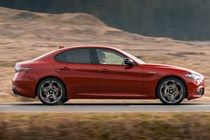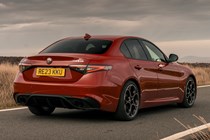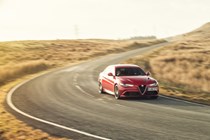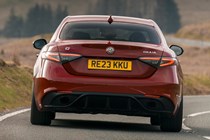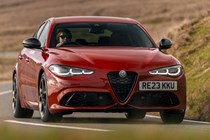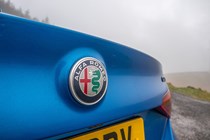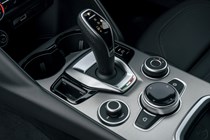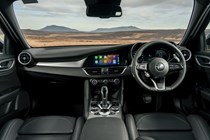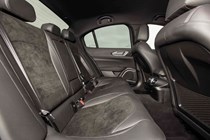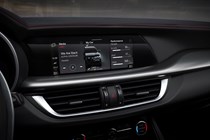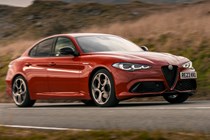
Alfa Romeo Giulia long-term test
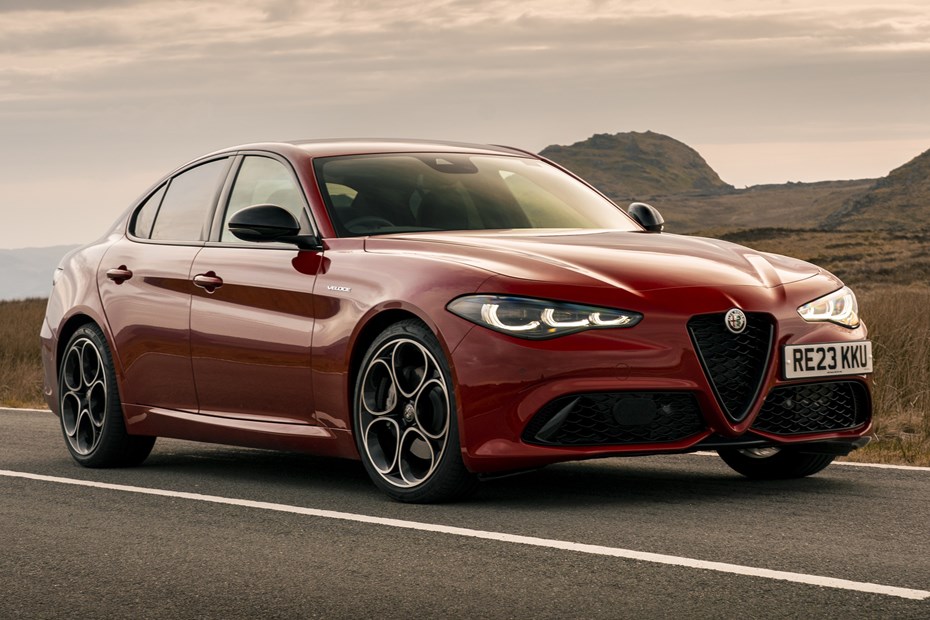

Introducing James Dennison’s latest long-term test car – a Misano Blue Alfa Romeo Giulia Veloce. Is this stylish saloon as easy to live with as its German rivals?
Reports by James Dennison
Update 2: First impressions – four likes, four dislikes
Update 3: How much does it actually cost to own an Alfa Romeo Giulia Veloce?
Update 4: Practicality review, plus an update on the sat-nav issue…
Update 5: Giulia Veloce vs Giulia Quadrifoglio
Update 7: An alternative viewpoint
Update 1: Welcome
Getting to know the Alfa Romeo Giulia Veloce.
There’s a saying among car enthusiasts that goes along the lines of – ‘if you’ve never owned an Alfa Romeo than you’re not a true petrolhead’. For those that don’t lie awake at night pondering all things automotive, this might sound a little odd. And indeed, it is difficult to explain without delving into the usual cliches around the ‘soul’ and ‘passion’ and, ahem, temperament of Italian cars.
But here’s the thing, you will not catch anyone who has no interest in cars driving an Alfa Romeo. Instead, they’ll often buy one of the many rivals on offer and – usually – be very satisfied with their decision. Why am I telling you this? Well, my new long-term test car is an Alfa Romeo Giulia Veloce.
I’m running it to find out whether this famous Italian brand can make a car that’s not just impressive over a week-long test drive, but also as easy to live with, as say, my old BMW 4 Series long-termer. Along the way, I’ll find out how much it costs to buy and run the Giulia per month, whether anything goes wrong and, of course, how it compares in a group test with its biggest rivals.
As well as the updates on this page, I’ll also be producing a series of video diary episodes on the Parkers Cars YouTube channel, showcasing my time with the Giulia. Be sure to head over and have a look, plus don’t forget to subscribe to the channel and turn your notifications on.
Watch the first episode of my Alfa Romeo Giulia Veloce video diary series here.
What spec is my Giulia?
While the incredible Quadrifoglio version of the Giulia would have been nice, I wanted a spec that would show off the car’s strengths yet also be attainable. Enter the Veloce. Essentially, it’s a Quadrifoglio lite and delivers that extra bit of desirability over the base Sprint model.

Priced from around £40k, the Veloce gets a 280hp 2.0-litre turbocharged four-cylinder petrol engine teamed to an eight-speed automatic transmission. Other markets get all-wheel drive, but in the UK it’s rear-wheel drive only. No doubt this would improve the 5.7-second 0-62mph time, but I’m not complaining.
Giulia Veloce standard equipment
As for standard kit, the Veloce benefits from a useful spread of technology and visual upgrades, including:
- 8.3-inch touchscreen infotainment system with sat-nav, Apple CarPlay and Android Auto
- A wireless phone charger
- Active cruise control
- Leather upholstery heated front seats (and steering wheel), plus electric adjustment with memory function on the driver’s side
- Front and rear parking sensors, plus a rear parking camera
- 19-inch alloy wheels (Y Spoke on my car)
- Sports front and rear bumpers
- Dark finish Giulia and Veloce badges, plus tinted rear windows
Giulia Veloce optional equipment
I’ve also opted for the striking Misano Blue paint and the Driver Assistance Plus Pack that, for £1,000, adds:
- Automatic high beam system
- Lane Keep Assist and Highway Assist System (HAS)
- Traffic Sign Recognition (TSR)
- Traffic Jam Assist
- Active Blind Spot Assist
- Driver Attention Assist
- Electrochromic rearview mirror and wing mirror with electrochromic autodimming
- Intelligent Speed Control
One thing I don’t have on this car is the optional Performance Pack A, that adds a limited-slip differential and, more importantly, adaptive dampers – or as Alfa calls it, Synaptic Dynamic Control (SDC). Having been lucky enough to run a number of cars with adaptive dampers over the last couple of years, I’m keen to see what Alfa’s engineers can do with the one-size-fits-all passive setup. Making a car ride and handle properly with four switchable suspension tunes is much easier than picking that perfect compromise with a fixed setup.
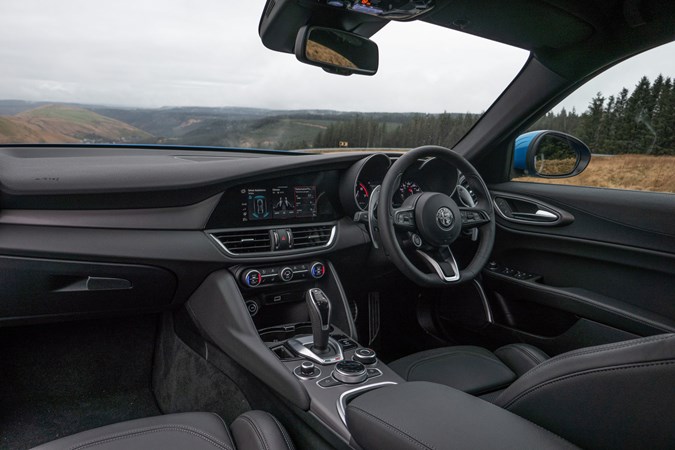
So, I’ll be keeping a close eye on the ride and handling, but also other aspects of the vehicle such as the upgraded infotainment system (available since the 2020 model year update), general quality and those interesting ‘quirks’ we’ve often seen in cars from Alfa Romeo – existing owners will know what I’m talking about!
For now, though, I’m excited to have picked up the Giulia Veloce and am already convinced it’s the best-looking exec saloon out there. The Misano Blue paint, blacked out details and yellow brake calipers give it a subtle presence that doesn’t always come through in pictures yet looks incredible in the flesh.
Starting mileage: 1,198
Claimed average fuel economy: 38.2mpg
Update 2: First impressions – four likes, four dislikes
One month in with the Giulia Veloce! Read on for my initial likes and dislikes…
It’s been just over a month since I picked up the Giulia (or rather, Giuliana – as she’s been christened) and I’ve managed to put a healthy number of miles on the odometer. For this month’s update then, I’m going to keep things nice and simple and list four things I like about the car so far, and four things I don’t. We’ll start with the good bits…
Watch the second episode of my Alfa Romeo Giulia video diary series here
Plush ride comfort
Delve into the options for the Giulia Veloce and you’ll see that you can spec something called the Performance Pack A. It’s an upgrade that costs about £2k and includes adaptive dampers. My car doesn’t have it, so instead I’ve got cheaper passive dampers with just the one setting. But despite this, the ride quality is deeply impressive. Urban roads, motorways, B-road blasts – it’s very difficult to make this car feel uncomfortable. Top work by the Alfa engineers.
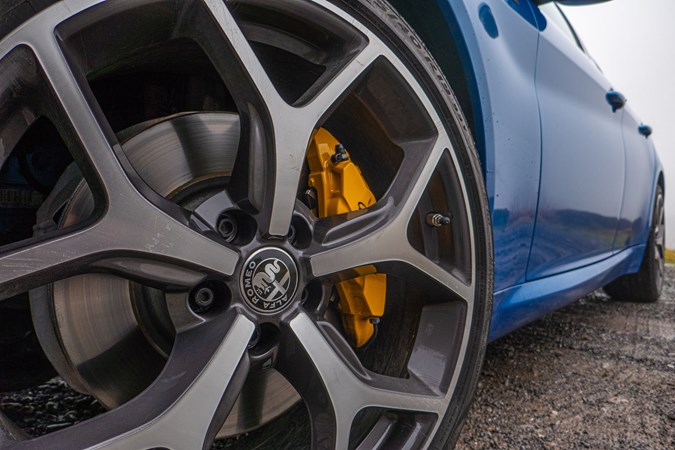
Fun handling
Granted, many cars with passive dampers manage to pull off a good ride quality. However, the flipside of this is that most of them aren’t that sharp to drive when you start to have fun in the corners. Not so with the Giulia Veloce… Somehow, it’s comfortable and sporty to the point where it is – in my view – the best handling saloon car at this price point.
Knockout looks
Some people aren’t totally convinced by the Giulia’s looks and maybe they’ve been spoiled by gloriously pretty Alfas from the past. In my eyes though, this is the best-looking saloon on sale today and my car – with its Misano Blue paint, yellow brake calipers and Veloce tweaks – is a fine example.
Zingy engine
We’ll go into more detail about the engine in a later report, but for now all I’ll say is I’m rather impressed. A 2.0-litre 280hp turbocharged four-cylinder petrol, it does almost everything I want. Pace is impressive (0-62mph in 5.9 seconds), it sounds good and there’s plenty of freedom in the way it revs. Only thing I’m not totally sold on so far is the fuel economy. Maybe I’m being unfair, but I was hoping for a little more than 32mpg.
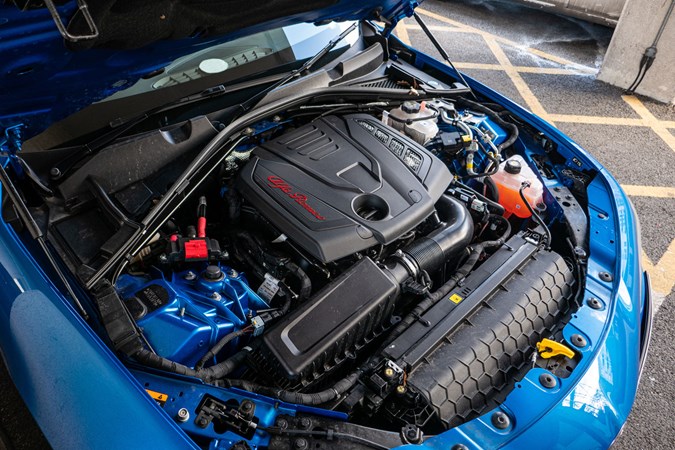
And now, for the not so good bits. Although most of which I’m hopeful can be fixed by a visit to the retailer…
Wind noise
As mentioned, the ride and general refinement on the Giulia is excellent. However, I can’t help but notice excess wind noise around the wing mirrors/front side window areas. Is there a piece of trim out of place on my car, or is this just a Giulia thing? More investigation necessary…
GPS issues
While using Apple CarPlay, the car’s GPS can ‘lose’ its position, rendering the sat-nav useless. However, if I unplug my phone (and thus disconnect CarPlay), the mapping software instantly re-establishes location, yet the car’s onboard sat-nav is still lost. I’m hoping it’s just a software issue and will report back in future updates.
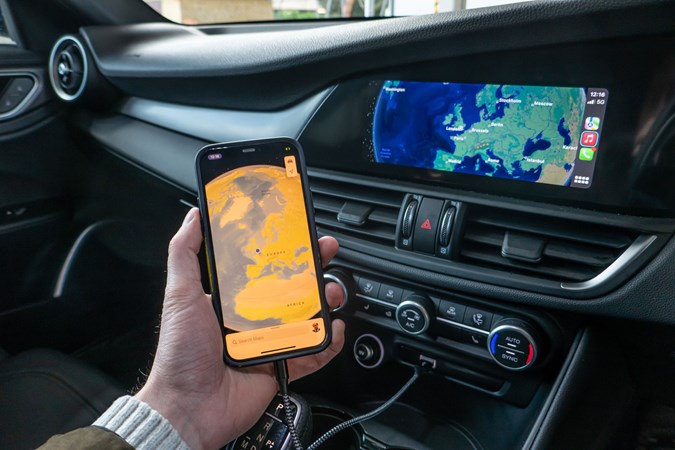
Missing tech
Maybe I’m being fussy here, but the Giulia is lacking a couple of pieces of kit that many rivals (and many cheaper cars) offer either as an option or as standard. For example, there’s no auto-hold function for the handbrake (handy at traffic lights) and the side mirrors don’t automatically dip when you put the car in reverse. That said, setting one of the memory seat positions with the mirrors pointed down works pretty well in place of the latter!
Beeeeep!
Last on the list of issues is the jarring high-pitched ‘beep’ when you lock or unlock the Giulia. It’s a shrill sound that only serves to draw attention to the car and cannot be switched off in the infotainment system. I’m hoping my local Alfa retailer will have a workaround.
So that’s it for my first impressions on my Giulia Veloce. They’re overwhelmingly positive with a couple of niggles here and there (many of which I’ll try and get sorted in the next few months).
Mileage: 4,217
Average fuel economy: 31.9mpg
Update 3: How much does it actually cost to own an Alfa Romeo Giulia Veloce?
James finds out how much leaves your bank account every month if you were to own a Giulia Veloce
It’s easy to find out what the cash price is for an Alfa Romeo Giulia Veloce – £43,799. But, if like most customers you’ll pay for the car on a PCP or lease deal, how much does it actually cost to buy and run?
Fair warning, this won’t be the most exciting update I’ll ever write about my Giulia Veloce, but it should certainly be one of the most useful. See, since the vast majority of new car purchases are now done on finance, the up-front cash price doesn’t carry as much significance as it once did.
Watch the third episode of my Alfa Romeo Giulia Veloce video diary series here
What’s more important, is how much will have to leave your bank account every month to allow you to use the car in question. And, while we’re at it, we may as well factor in insurance, tax, servicing costs and fuel bills as well. Also, a bit of context would be helpful, so I’m going to do the same calculations for the BMW 330i M Sport – one of the Giulia Veloce’s biggest rivals.
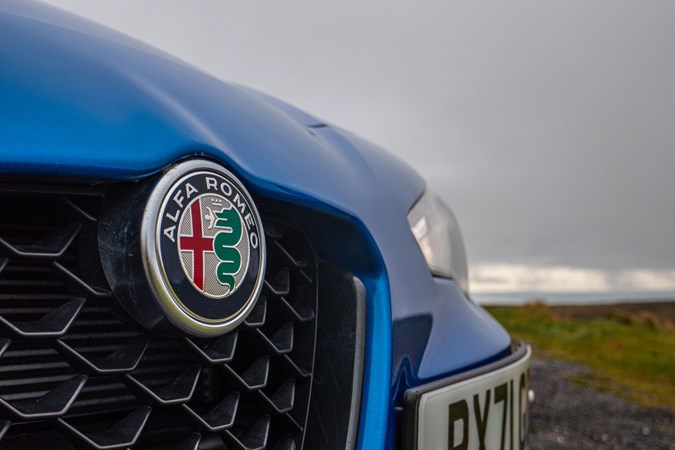
Alfa Romeo PCP
Starting with the car itself, we’re putting down a £5k deposit on a Giulia Veloce with no optional extras. The contract will last 36 months and be limited to 12,000 miles a year. Plug this into Alfa Romeo’s finance calculator and you’ll find that this works out at 36 monthly payments of £619, with an optional final payment of £18,373 (this includes an Alfa Romeo deposit contribution of £1,250). Overall, this adds up to a sum of £46,287 (£2,488 more than if you’d paid in cash), thanks to an APR of 3.0%.
Fuel, insurance, servicing and tax
We’d rather we didn’t have to pay for all of the above, but unfortunately we do and it does add up! Starting with insurance, I’m breaking out my alter ego Ken Dennis. He’s 40 years old, married, lives in Peterborough and works as an accountant. He uses the car for social, domestic, pleasure and commuting and keeps it on the street outside his house. Finally, he’s had his licence for 20 years and a no-claims bonus for 10 years.
Using a popular price comparison site, the cheapest quote I could get was £974 per year, or – if paid in instalments – £82 per month. As for fuel, I’m currently getting around 32mpg from the Giulia Veloce, so over 12,000 miles at today’s fuel price that equals £2,574 per year.
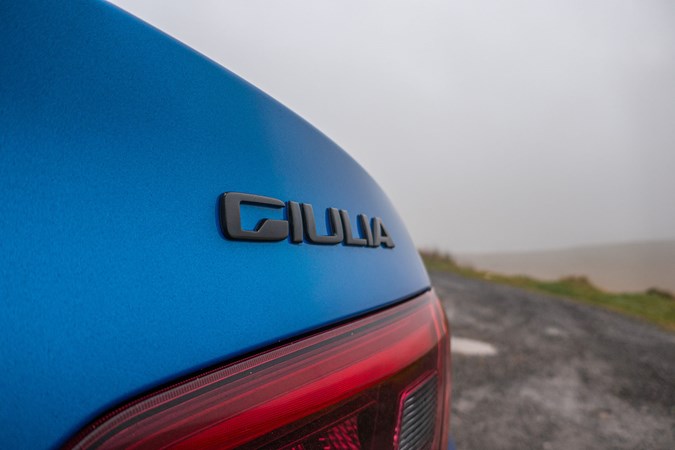
Servicing comes courtesy of Alfa’s up-front service plan and costs £699 over three years, while tax for year two and three (year one is included in the purchase price) is hefty thanks to the Alfa coming in at over £40k from new. Mark that down as £490 per year.
Including the £5,000 deposit, I make that a first-year cost of £16,675 (£1,390 per month) and £11,466 (£955) for years two and three.
Is it cheaper than a BMW 330i M Sport?
In cash terms? No, the Alfa comes in around 5% more than the BMW – £43,799 vs £41,435. Naturally, there’s an argument about respective equipment levels and what one car offers that the other may not, but we’ll leave that aside for the moment and just focus on the basic price.
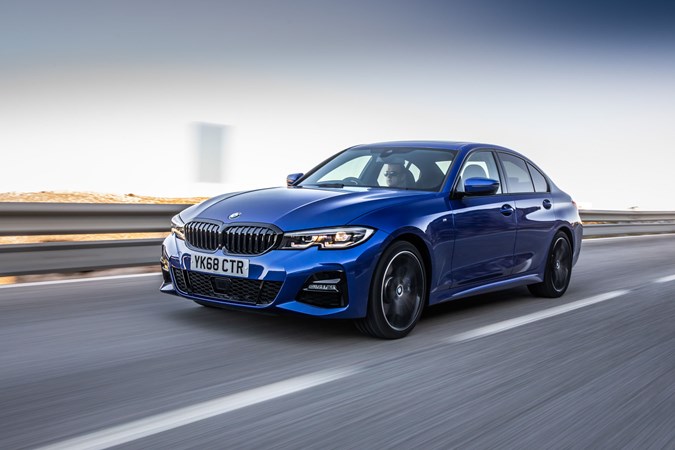
Using the same structure as the Alfa Romeo arrangement, the BMW Select PCP finance deal offers a 3.9% APR rate and, crucially, a contribution from BMW amounting to £2,016. This means that the monthly repayment on the 330i is £568, with an optional final balloon amount of £17,547, thus working out at £42,471 in total.
I don’t have my own real-world MPG figures for the BMW, but a bit of research suggests it’s a little better than the Alfa and well into the mid-thirties. Insurance is also comparable at £980, while tax is identical. All in all, that’s about £15,384 for the first year of ownership, dropping to around £10,874 for the subsequent two years – or rather £1,282 and £906 a month respectively. Which is about £100 and £45 less than the Alfa.
If you’re interested in totals, I make that £39,607 for the Alfa and £37,132 for the BMW if you hand back after three years. If you complete the purchase, it’s £57,980 and £54,679 respectively. Therefore, the Alfa Romeo is the more expensive car with the majority of that down to the manufacturer PCP deal.
In summary, I wasn’t expecting the Giulia to beat the 3 Series on running costs and manufacturer PCP deals, largely due to each car’s differing residual values. However, while the Alfa Romeo is noticeably more expensive, it’s not to the degree that makes it an unjustifiable proposition – especially when we only consider running costs.
Tune in next time when I drive a brand-new version of the Giulia, due on sale later in 2022!
Mileage: 5,333
Average fuel economy: 32.1mpg
Update 4: Practicality review, plus an update on the sat-nav issue…
James assesses the Giulia’s space and practicality as well as heading to the Alfa Romeo retailer to try and iron out some early issues with the car.
As we enter month number four of my time with the Alfa Romeo Giulia Veloce, I thought it best to take care of some practical matters. The first being my thoughts on the Giulia’s passenger and boot space (which I’ll get on to it a bit) and the second discussing the recent experience I had when taking the car back to the dealership for a light check-up.
Have the gremlins been fixed?
Ever since I had the car I’ve noticed a couple of things that I was sure weren’t right. I alluded to them in an earlier report, so thought I’d try my best to get the wind-noise and sat-nav issues fixed. That meant a trip to Thames Alfa Romeo Slough where I had the handover at the back end of last year.
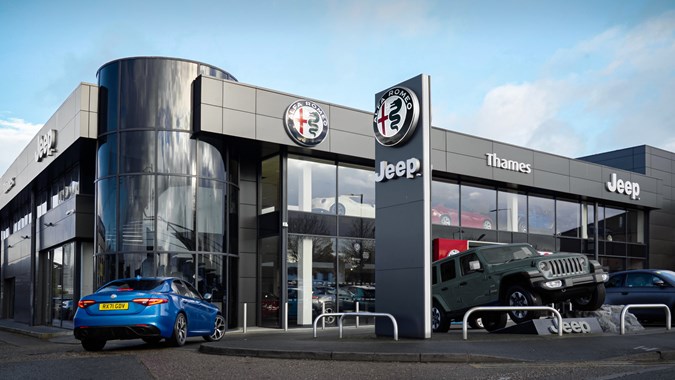
I was booked into a service slot around 3 weeks after my initial phone call (the earliest one they had) and duly dropped the car off in the morning, taking the keys to a Alfa Romeo Stelvio SUV review as my courtesy car. I was kept up-to-date on how the appointment was progressing via the online service portal and was able to pick the car up a couple of days later.
The verdict? Well, somewhat disappointingly, the excessive wind-noise around the wing-mirrors and A-pillars was deemed acceptable for the car, so I can only conclude that they must be a feature on the Giulia. Happily however, a software update on the infotainment system did the job when it came to fixing the buggy sat-nav. No longer does the car lose its position halfway through a journey and leave me driving around in circles. Hurrah!
All-in-all, one of the better service experiences I’ve had from a manufacturer and one I would be sure to recommend. Some may say that I got preferential treatment as a car reviewer for a major publication, yet even before this became apparent I got what felt like the beginning of a swift, efficient experience.
How practical is the Alfa Romeo Giulia?
For those sitting in the front, the Veloce benefits from standard-fit electric seats so there’s plenty of adjustment to help you get comfortable. Elbow room is good and you rarely feel cramped. Meanwhile, storage space is reasonable with decent door pockets, space under the armrest, a wireless charging pad and a cubby underneath the centre console (which, incidentally, is usually where I keep my phone).
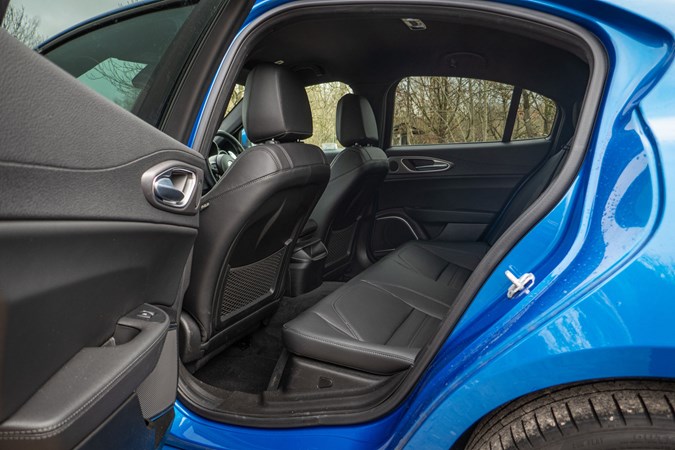
One thing I have noticed about the aforementioned electric seats however, is that the driver’s seat moves back and forward automatically in order to allow easier access behind the wheel. Great, nice feature, but it does mean that if you have rear seat passengers, the driver has to climb in and then turn the engine on before anyone clambers in behind them. Do it the other way around and there’s simply not enough legroom for the offside rear-seat passenger to get in comfortably. You can, however, turn this feature off if it becomes a real pain.
This aside, rear seat passenger room is usable despite the apparently low roofline. Those significantly over six-foot will struggle, but otherwise it’s comfortable enough in the back of the Giulia – even if luxuries such as USB points or a separate climate control zone are conspicuously absent. Also, there is a middle seat, but the chunky central tunnel (as seen on a lot of cars) robs legroom so it’s best used only for shorter journeys.
Finally, boot space is comparable with the BMW 3 Series Review and Audi A4 review at 480 litres and larger than the Mercedes-Benz C-Class review at 455 litres. 40/20/40 split-folding rear seats are also standard on the Veloce and can be triggered via handily placed levers in the boot. Wheel arch intrusion is noticeable and it can have an impact when loading very heavy items, but it’s no issue when carrying suitcases and other large bags.
Tune in for the next update where I compare my Giulia Veloce with its Quadrifoglio bigger brother!
Update 5: Giulia Veloce vs Giulia Quadrifoglio
James tries out the bigger brother of his Veloce in an inter-family battle of the Giulias
It had to happen at some point didn’t it? I’d held off on booking in the fastest mainstream version of the Giulia for fear of it spoiling the Veloce I’m running. But after five months it seemed an appropriate time to bite the bullet and find out what the fuss is about.
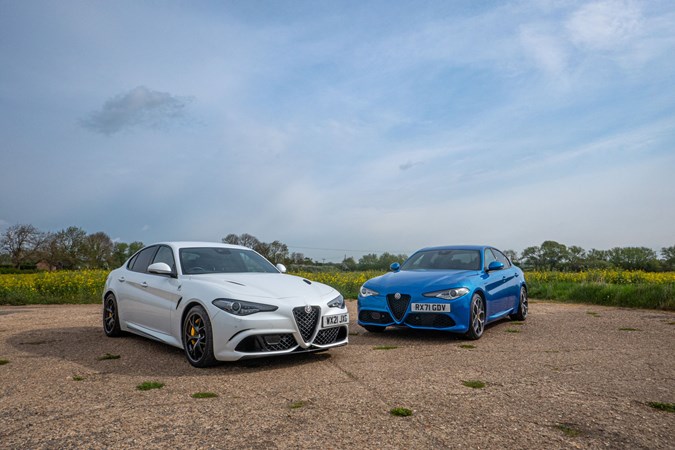
Yep, believe it or not, an extended drive in the regular Giulia Quadrifoglio had escaped me in all the years it had been on sale so I was naturally intrigued. Read on for my Veloce vs Quadrifoglio comparison, plus don’t forget to watch the video on YouTube.
Veloce vs Quadrifoglio on paper
Top line stats are as follows. The Giulia Veloce costs from around £45k and uses a 2.0-litre four-cylinder petrol engine that delivers 280hp and 400Nm of torque to the rear wheels. It comes as standard with an eight-speed automatic gearbox and hits 62mph from a standstill in 5.7 seconds. Strong figures in anyone’s book.
Meanwhile, the Giulia Quadrifoglio starts at around £74k but boasts a Ferrari-derived 2.9-litre V6 with 510hp, 500Nm of torque and 0-62mph in 3.9 seconds. It also uses an eight-speed automatic gearbox with power sent exclusively to the rear wheels. The QV gets adaptive dampers and torque vectoring as standard, as well as an optional Akrapovic exhaust system and Race setting on the drive mode selector.
How do they feel in the real world?
I’ll start by saying that after doing hundreds of miles in the QV (and having an enormous amount of fun in the process) I didn’t feel disappointed getting back into the Veloce – which in itself is probably one of the best compliments going.
That’s because the QV is honestly one of the finest mainstream road cars I have driven in over six years of road testing. For starters, the engine is bristling with power and urgency yet the smoothness and linearity of the way it delivers its 510hp is deeply satisfying. Paired with the snappy eight-speed ZF automatic gearbox and optional Akrapovic exhaust, it’s a model powertrain at any price point.
Then there’s the handling. Twisting the drive-mode selector into Dynamic or Race mode firms the car up and sharpens the already keen responses to create a driving experience most sports cars would be proud of. Central to this is the low kerb weight. At just over 1,500kg it’s several hundred kilos lighter than both the Mercedes-AMG C63 and BMW M3, allowing the Giulia to feel like it’s working the chassis far less than its rivals.
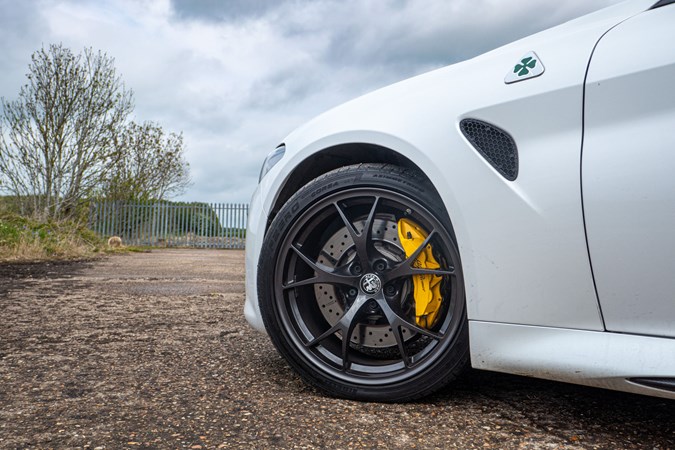
And yet for all this fun and performance, perhaps the QV’s greatest party piece is how civilised it becomes when you take it out of the sportiest modes. The ride, the gearbox, even the engine settle down to deliver a relaxed, easy-going driving experience that’s not far removed from what the Veloce can produce. If there was ever proof that Alfa Romeo’s engineers are some of the best in the business when it comes to dynamics, this has got to be it.
Back to the Veloce, though, and I’m impressed with how the cabin still has that same driver focus as the QV. The lovely aluminium gearshift paddles, the ergonomic steering wheel and simple control panels – it may not be as tech-laden as a Mercedes or Audi but there’s a lot to be said for the ease of use.
Out on the road, the Veloce (even on passive dampers) maintains the wasp-like agility of the QV and only feels a touch softer when pressing on. Bumps and cracks in the tarmac are also handled deftly, but it’s disappointing to see the Veloce suffering from markedly more wind noise around the mirrors (I’m still convinced this is an issue unique to my car, rather than the model as a whole).
The Veloce’s engine also feels like it could do with loosening up a little compared with the QV’s. Of course, it’s not going to be as quick, but it only comes alive in Dynamic mode which seems a shame for everyday driving.
And what about the price difference?
As mentioned above, there’s about a £30k difference in the starting list price of both cars (£45k vs 74k). Should you convert this into a PCP finance price (which most buyers will), that works out at £716 per month for the Veloce and £1,324 a month for the QV (36 months, £4,250 deposit). That’s a huge leap in anyone’s book and, objectively speaking, it makes the Veloce look like exceptional value.
Verdict
I think we all know which car we’d go for if money was no object. The Giulia Quadrifoglio is a spectacular piece of engineering and one that would probably make it into my dream garage. But full credit to the Veloce, it doesn’t feel like the poor relation. It still maintains the wonderful chassis of the QV and would be even closer had Alfa given the engine a little more sparkle. So if you can afford the QV you’ll be getting plenty of envious glances, but the good news is that you won’t feel short-changed in the Veloce – I know I don’t!
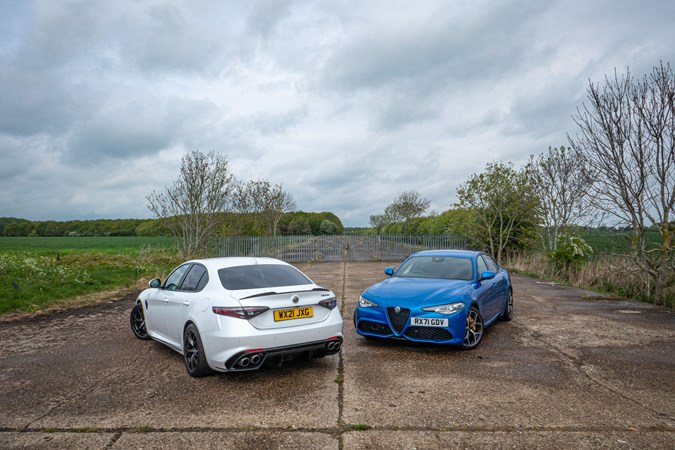
Mileage: 9,121
Average fuel economy: 32.3mpg
Update 6: 10,000-mile update!
The Giulia Veloce reaches a major milestone, but has it been reliable over the first 10k miles and six months?
Here it is, 10k miles since I took delivery of the Giulia! OK, it might not sound like much (although owners of older Alfas may beg to differ) but owing to less driving due to Covid over the last couple of years I can’t remember the last long-termer I had that hit a hundred centuries.
So with this in mind, I thought it best to mark the occasion by doing a mini status report on the last six months and 10,000 miles. How the car’s behaved, has anything gone wrong and would I change the spec if I could do it all again? Read on to find out more and don’t forget to check out the accompanying video at the link below.
VIDEO: Alfa Romeo Giulia 10,000-mile update!
Alfa Romeo Giulia Reliability and Running Costs
The million-dollar question. How reliable has my Giulia been so far? Well, over the first 10,000 miles it’s been excellent. The only issues that needed addressing were the GPS often getting lost (fixed with a dealership software update) and the tyre pressure monitoring system sounding the alarm for no reason (fixed itself). Aside from that, it’s shown an excellent record – no doubt helped by the fact the Giulia has been around for a good few years now, thus helping Alfa Romeo iron out any issues on later cars.
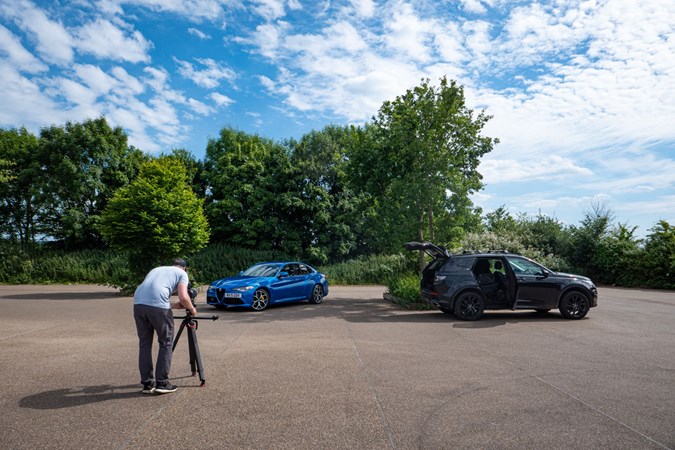
As for fuel economy, I’m still averaging around 32mpg. I did expect this to be higher after running the car in, as similarly (or more) powerful BMW and Audi models are capable of high thirties and often more. That said, the brakes pads and tyres still have ample life left in them so there’s been no other additional costs over the last 10,000 miles.
Alfa Romeo Giulia Veloce spec
Here’s a question I’ve been asked a few times. Would I still get the same spec on the Giulia if I were buying one tomorrow? And the answer is, yes, absolutely. I still marvel at just how good the Giulia Veloce looks with its subtle sporty bodywork and Misano Blue paintwork – the latter surprisingly rare in the UK according to how many other Giulias I’ve seen wearing it.
The 19-inch Y-spoke alloy wheels on my car are no longer available on the Veloce, but the 19-inch Dark Petal design is perhaps even more attractive. Also good news is that the limited-slip rear differential also now comes as standard, while the £1,000 Driver Assistance Pack is still worth having.

Some may be tempted by the Giulia Estrema extra standard kit (including adaptive dampers that are now not available on the Veloce), but as I’ve mentioned in a previous update the standard passive dampers are the better bet. Thus, the £5.5k price difference between the Giulia and Estrema just doesn’t seem worth it.
Mileage: 10,447
Average fuel economy: 32.1mpg
Update 7: An alternative viewpoint
Women have a major influence on 89% of car-buying purchases – so what does James’ other half think of the Giulia?
Having driven the Alfa Romeo Giulia around for several months now, I wanted to get a second opinion of the car. Not from my esteemed colleagues (who all agreed that they were fans of the Alfa), but from someone far, far harder to please. The kind of person that in a split-second can put paid to years of development and engineering, simply by declaring that if there’s no heated seats, the car in question is a pointless waste of time.
Meet Emma, she’s my significant other of seven years and as such has rode shotgun in and driven hundreds of new cars. She’s also owned a few as well, her latest steed being an Abarth 595 Trofeo in Giallo Modena yellow. Clearly, she’s a lady of distinguished taste.
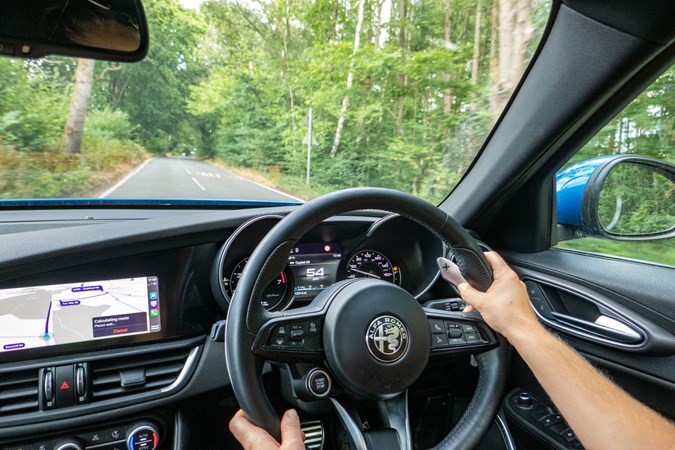
More importantly, studies show that women have a major influence in 89% of car purchasing decisions in the UK. Of course, much of this is from their own car purchases, yet it’s clear that even when it’s a male buying the car, nine out of ten times they will be steered by an important lady in their life.
With this in mind, I spent a few minutes quizzing the other half to get her honest impressions on the Giulia. Here’s what she thought:
JD: So, what are your favourite bits about the Giulia?
E: Getting into it for the first time, I liked how I could just plug my phone in and Apple CarPlay worked straight away – no messing around. That certainly helped with the unfamiliarity aspect. Also, all the most useful buttons (from my point of view) are within easy reach on the steering wheel. Oh, and speaking of the that, it’s not too chunky. It annoys me when car makers install those steering wheels that are clearly designed for larger male hands and have zero regard for female drivers with smaller hands. Instant turn off!
JD: Anything you don’t like?
E: It took me a while to figure out when you needed to press the button on the gear-lever, although I’m thankful it actually had a lever – I know some cars don’t. Also, because I have short legs I found that in my seating position the A-pillar was right by my head which impacted visibility somewhat. This meant the sat-nav screen was in a slightly awkward place relative to where I was sitting, so was harder to glance at. I’m 5ft 6 inches, so by no means tiny but still found it a little awkward.

JD: Would you change anything?
E: I wished the cruise control wasn’t adaptive. I get why it’s useful and I seem to remember the 4 Series having a better system. But on this one it was very keen to hit the brakes regardless of the setting I had it on. Maybe I just needed more time to get used to it. The feature where you hold your foot on the brake and it activates the handbrake (auto-hold) would also be nice!
JD: Would you buy one, or encourage me to buy one?
E: Yeah. I would actually. There were a few issues but on the whole I got on well with it and loved the styling. It would complement my Abarth very nicely. Although, actually, the one I really want is the Quadrifoglio…
Mileage: 11,617
Average fuel economy: 32.3mpg
Update 8: Goodbye
James bids farewell to his Alfa Romeo Giulia Veloce – but would he buy one with his own money?
Here we are. Seven months on from collection and my time with the Alfa Romeo Giulia Veloce has come to an end. I know I always say this with long-termers, but I really do feel sad to see it go. It’s covered over 12,000 miles, conquered three vastly different seasons in the UK and reminded me how an everyday car should drive and handle. In short, it’s done everything I’ve asked of it and more. Read on for the final verdict.
Watch the full video review of the Alfa Romeo Giulia Veloce
The good
It would be remiss of me to start this section by talking about anything else other than the way the Giulia drives. It’s sublime. The ride quality, even on the passive dampers, is excellent and keeps the occupants isolated from all but the worst road surfaces. It’s a real feat of engineering from the team at Alfa Romeo and, honestly, they’ve done a better job than any of their rivals.
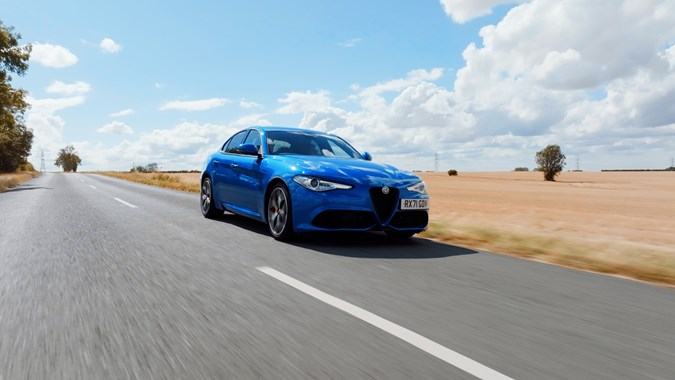
What’s even more impressive, is that despite the smooth and comfortable ride the Giulia’s handling is even more of a standout. You see, making a car ride properly is one thing, but then complementing this ability with exceptional balance and cornering abilities is something entirely different – especially without the benefit of adaptive dampers that change stiffness at the push of a button.
Driven enthusiastically, the Giulia is the finest handling saloon car of the lot, beating rivals from BMW and Jaguar that are often praised for their dynamic ability. In the Giulia, the steering is sharp and responsive, the grip levels high and the feeling of agility unmatched. In fact, it’s spoiled me because getting in many other cars with sporting intentions now feels largely disappointing.
Granted, it’s not quite a Giulia Quadrifoglio, but there’s more than enough about the Veloce to link it to its sublime bigger brother. Which, by the way, is still the finest mid-sized performance super-saloon on the market for me.
I’m also a huge fan of the Giulia’s looks and styling, especially in the optional Misano Blue paint that really makes it pop in any photos/videos we’ve shot with the car. Beauty is – of course – in the eye of the beholder, so while a few people have suggested things such as ‘it’s not as pretty as older Alfas’ or ‘it’s too generic looking’, the vast majority have been impressed. Indeed, when I’ve just taken it for a clean the amount of nods and turned heads the car gets is far more than you could expect from any of its rivals.
Finally, the cabin space and standard equipment is worth a mention, the former especially due to the sleek exterior looks. On a weekend spent ferrying people and luggage back and forwards to Silverstone, the Giulia coped admirably and I heard no complaints from the rear seat passengers. I also found the heated steering wheel, electronically adjustable leather seats (with memory function) and keyless entry super useful – all features being standard on the Giulia Veloce.
The bad
As for the bits I was less keen on, regular readers will know that I wasn’t a fan of the high pitch beeping sound that emanates from the car whenever you lock or unlock it. I get why it’s there, but surely there should be a way to turn it off?! Also frustrating was the unsolved wind noise issue from around the wing mirrors. Some readers said they’d experienced similar, others not. That and the fact I had no such issues on the Giulia Quadrifoglio version suggest it may be a build quality issue.
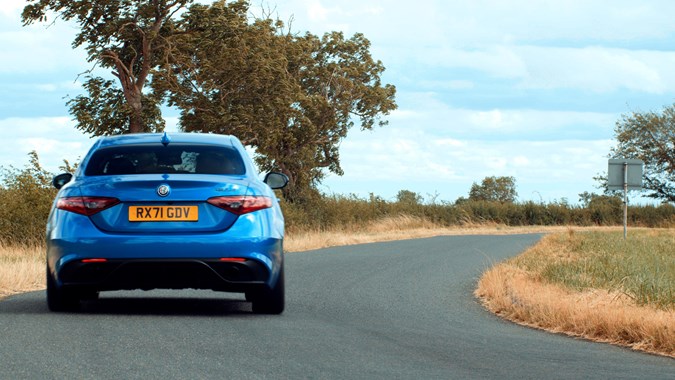
My final gripe (apart from the pricey PCP deals) is with the engine and gearbox – the former being something I’ve changed my opinion on since my early days with the car. When you’re driving enthusiastically on a nice road and flicking through the gears using the lovely big metal paddles, everything is great. However, driving around town I do wish the engine and gearbox felt a little livelier. For example, if you wanted to nip into a gap or needed a quick burst of acceleration, the gearbox is slow to serve up the power. It’s nowhere near as responsive as, say, a DSG/S Tronic transmission from the VW Group.
I don’t think it’s helped by the engine, which at low revs can feel sluggish. Popping the drive mode selector into its sportiest setting does make a notable difference, but then you must contend with overly heavy steering as you cannot customise presets to your preference – not so with most rivals. Finally, I have to bring up fuel economy. An average of 32mpg may sound respectable from a 280hp saloon, but the reality is that rivals can and will deliver more.
Should you buy one?
A viewer on one of my Giulia YouTube videos recently asked whether I would pick the Alfa Romeo over the BMW 420i I ran last year. And my answer was, yes, I’d rather have the Giulia largely because of how much fun it is to drive. However, had they have asked me whether I’d recommended the Giulia over the 4 Series, it would really depend on who the potential buyer was.
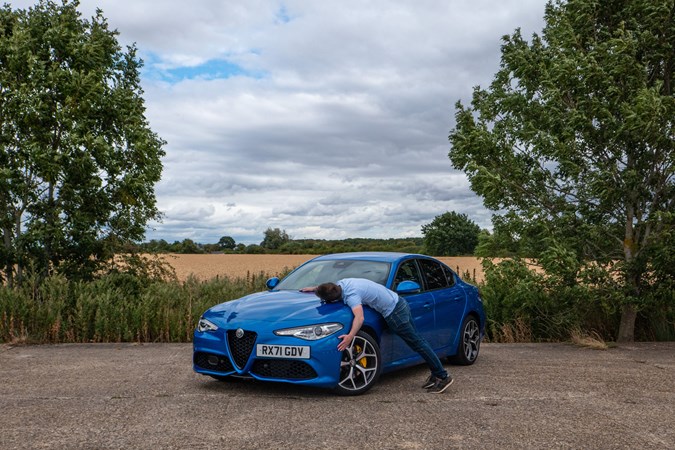
See, where the Giulia is good, it’s really good. I’m not going to get started on the ride and handling again otherwise this article will never finish – but sufficed to say it’s a masterpiece. However, when compared with cars from Audi, BMW and Mercedes-Benz, the Giulia does fall short in key areas such as onboard tech and value-for-money on finance. Therefore, the answer on whether you should buy one depends very much on what you value in a car. The Giulia isn’t a one-size-fits-all solution in the same way that the Audi A4 and BMW 3-Series are (this is likely why both outsell it by a clear margin).
If it was my money, I’d pick the Giulia all day long because it absolutely nails what I want from a car like this. No doubt it’s due to be superseded by a newer model soon (I keep forgetting it’s six years old!), so I just hope that Alfa Romeo manages to carry over that brilliant drive and update the tech to match its German rivals.
If anyone else has any Giulia ownership impressions they’d like to share, please get in contact on Twitter, Instagram or at james.dennison@parkers.co.uk. Alternatively, why not leave an owners review on our site?
Mileage: 12,429
Average fuel economy: 32.5mpg



